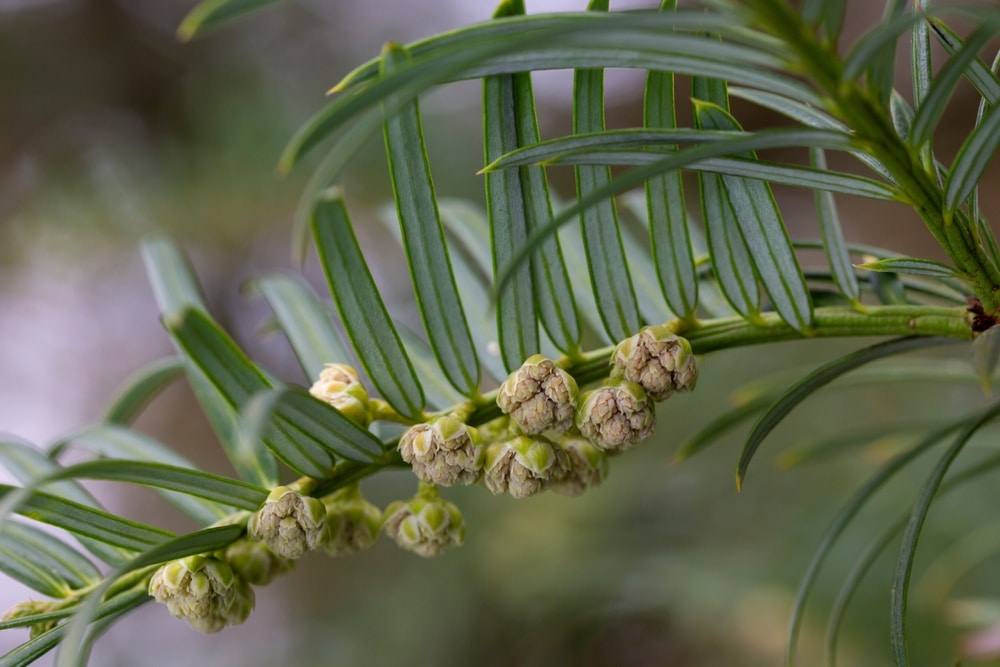If you’re looking for a shade-loving plant that you can use as a hedge, the Yewtopia Plum Yew is a great option. It is a compact evergreen that can be easily pruned to create the shape you desire.
Although slow-growing, it can reach up to 10 feet tall and 6 feet wide at maturity. The Yewtopia Plum Yew has a deep green color with a purple tinge that makes it an attractive addition to any landscape.
Aside from being used as hedges, this plant also makes it ideal for foundation planting. This can be attributed to its upright spreading habit, which can provide a nice backdrop for your home.
When it comes to caring for the Yewtopia Plum Yew, there are a few things you need to keep in mind. Here is everything you need to know about Yewtopia Plum Yew care:
| Botanical Name | Cephalotaxus Harringtonia ‘Plania’ |
| Common Name | Plum Yew |
| Plant Type | Perennial |
| Flower Color | Not Applicable |
| Size When Mature | 120 inches tall |
| Bloom Time | N/A |
| Sun Requirements | Part sun to full shade |
| USDA Hardiness Zones | 6 – 10 |
| Soil PH Range | 6.0 – 7.0 |
| Soil Type | Sandy, well-draining, moist soil |
| Water Needs | Medium |
| Native Area | Japan, Korea, China |
What You Need to Know About Yewtopia Plum Yew
A beautiful needled evergreen plant that’s planted for their winter interest, its needled foliage gets darker during the winter. It sheds off some of its green shade and becomes a bit lighter green during the spring.
Although this plant doesn’t flower, its evergreen needles make it a good winter addition to your yard. Prized for its stunning deep green and purple-tinged needles, the Yewtopia Plum Yew gives your winter landscape life and interest.
A little bit of warning, however, this plant is extremely poisonous to animals. Keeping these plants out of your pet’s reach (if you have any), is essential.
How to Care for Yewtopia Plum Yew
Here’s everything you need to know about growing and caring for a thriving Yewtopia Plum Yew:
Light
One of the most difficult aspects of growing plants in shaded areas is finding one that will thrive in those conditions. The Yewtopia Plum Yew is one of those plants. It does relatively well in shaded and/or partly shaded areas, which is why it is often prized for its winter interest.
As long as it is getting some indirect sunlight, the Yewtopia Plum Yew will do just fine. A little bit of morning sun is ideal, but it can also tolerate some afternoon sun. Just be sure to not place it in an area where it will be getting direct sunlight for most of the day.
Although they’re not commonly planted as houseplants, if you wish to have these plants in pots, an east or north-facing window would provide the best light conditions.
Water and Soil Needs
This plant grows best in well-drained, moist soil that’s rich in organic matter. It doesn’t do well in waterlogged or extremely dry conditions. During its growing years, it needs at least 2-3 times of watering weekly.
However, once the plant has been established, it does pretty amazing and can tolerate some drought. Just make sure not to keep the soil dry most of the time as this hinders their growth.
Additionally, when watering your Yewtopia Plum Yew, be sure to water at the base of the plant and not on its needles. This helps prevent any fungal diseases that could potentially affect your plant.
Although it thrives in any type of soil, it does well in sandy soils that drain well. If your soil is on the heavy side, consider adding some organic matter to help with drainage. It prefers to be on a slightly acidic to neutral scale, from 6.0 to 7.0.
Temperature Requirements
Most yew plants are suited for hotter climates, but the Yewtopia Plum Yew, in particular, is cold hardy. It can tolerate temperatures as low as -20 degrees Fahrenheit and does best in USDA hardiness zones 6 through 10.
Fertilizer
The best fertilizer to use on Yewtomia Plum Yew is one that is high in nitrogen. This helps promote growth, especially during its growing years. A blend of slow-release and organic fertilizer is ideal.
Because they have a slow growth rate, this plant doesn’t need to be fertilized often. Once a year should be sufficient. Compost or manure can also be used as a natural source of nitrogen. Just be sure to not use too much as this could potentially burn your plant.
Common Diseases
A deer-resistant plant, the Yewtopia Plum Yew doesn’t have a lot of problems with pests or diseases. However, there are a few things to watch out for, such as:
Phytophthora root rot – This is a common disease that affects many types of plants. It’s caused by too much water and can be easily resolved by improving drainage and letting the soil dry out a bit.
Downy mildew – This is another disease that is caused by too much moisture. It’s easily recognizable as it causes the needles to turn yellow and/or brown. Again, letting the soil dry out will help resolve this issue.
Powdery mildew – This is a fungal disease that affects many types of plants. It’s recognizable by the white, powdery substance that appears on the needles. Improving air circulation and keeping the area around the plant free of debris will help prevent this disease.
Yewtopia Plum Yew Propagation
Yewtopia plum yew can live indefinitely as they naturally produce a lot of offspring. This is easily done through rooting the cuttings in water or soil. You can propagate the plant through stem cuttings, either in soil or water.
Choose a healthy stem that is about 8-10 inches long. Take into account that the stems should be thick enough, similar to a pencil’s diameter. Cut at an angle to prevent the cutting from rotting. Your cuttings can then be either placed in soil or water, whichever you prefer.
Timing is everything when it comes to propagating this plant. For some plants, the best time is to do it during the spring. Yewtopia plum yew is different. Its needles are greenest during late autumn to winter, so doing this before autumn is over is the most ideal time.
Once the cuttings have started to root, you may then transfer them into soil. Remember that the soil needs to be aerated, moist, and well-draining. Regularly water your newly rooted plants, keeping the soil moist, but never soggy.


